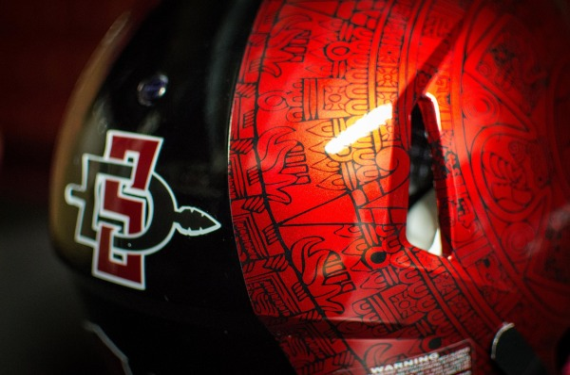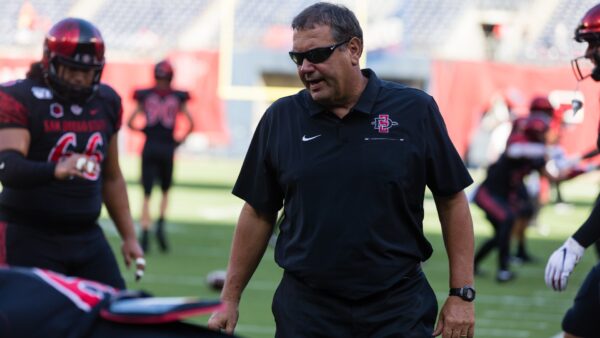SDSU set to begin fall camp with new NCAA guidelines

Credit: SDSU Athletics

One area where the marriage between lucrative athletics and universities has paid huge dividends for society is in the research of concussions. Using the full research muscle of the institutions where their teams play, the NCAA has helped fund major research into the nature, causes, and treatment of football-induced head injuries.
From 1999 – 2001, 2,905 football players from 25 colleges were assessed, with 184 found to meet the criteria for a concussion. Showing how universities are the perfect place for a study like this, those 184 players were clinically assessed immediately and then again after three hours, 1, 2, 3, 5, 7, and 90 days following the incident. Among other findings, the research showed that a person is most in danger of suffering a second concussion within the first seven to ten days after an initial one.
These insights led to a revolution in the awareness and treatment of concussions, and the advent of ‘concussion protocols’ swept across the sport. More than 15 years later, a follow-up study aimed to measure how these changes impacted athletes. They found that the more conservative treatment in recent years led to a dramatic reduction in the repeat concussions within the same season.
With this success in hand, the NCAA turned its attention to preventing head injuries in the first place. This past February, the results of a five-year study were released. The study used data from tiny accelerometers placed inside helmets to measure the collisions among football players. One of its key findings was that nearly half of all concussions occur in preseason camp. In response, this past May, the NCAA adopted rule changes to manage how coaches can schedule fall camp.
On Sunday, as SDSU embarks on its quest for the 22nd conference championship in program history, it will do so with a set of new guidelines. Some of the changes are: only nine times during fall camp are players allowed to be in full pads, certain blocking drills, most famously the ‘Oklahoma Drill,’ have been banned, and total practices with contact have been reduced from 21 practices to 18. SDSU head coach Brady Hoke spoke with the media on Thursday and is not too concerned about how the changes will impact the Aztecs.
“There’s not that much difference. I’ll be really honest with you,” Hoke said. “From what a lot of teams – us included – have been doing, it really isn’t that much different. … I think most of us have been kind of following our own guidelines.”
The Next Crisis
In the past 18 months, SDSU’s football program has gone through one major shift after another. First, Covid canceled spring camp last year. Once the season resumed, they were managed by protocols, which prevented a normal buildup to the season and progression through the season. Add to those the Name, Image, and Likeness changes, the one-time transfer rule, and the latest rumblings of conference realignment, and the Aztec coaches have had their hands full. It appears, though, the next challenge is on the horizon.

On July 27, the California State University system announced that every student on their campuses would have to be vaccinated from Covid “no later than September 30.” Throughout the past 18 months, the coaching staff has done all they could to educate their players on the benefits of the vaccine, and each coach in the program volunteered to be vaccinated. Still, they have also been respectful about the individual choices and beliefs their players and families have about the vaccine. With the CSU mandate in effect, however, there is no choice for Aztec players or any other SDSU student.
“You’re not just talking about your team. You’re talking about your student body,” Hoke said when asked about how the mandate would affect the Aztecs. “Obviously, there’s a lot of decisions that are going to be made, that people have to talk to different people. Our guys, I’m real proud of them what they’ve done – what they did last year and what they’ve done to this point. Are there going to be some situations that arise? I think so, but I’m real proud of where our team is.”
What those situations might be is anyone’s guess, but this issue is a developing story worth keeping an eye on as SDSU moves closer to the season and the September 30 deadline.
Position Battles and help from the freshman
Nothing has changed on the position battles from spring camp. On offense, the Aztecs need to find a QB and help on the offensive line. Defensively, they are looking to find a corner and a safety. The corner position Hoke emphasized because, in addition to picking a new starter among four candidates, they also need Tayler Hawkins to step into the role Darren Hall played last season.
[wpedon id=”49075″ align=”right”]
“With Taylor (Hawkins) and Trenton (Thompson), you feel good,” Hoke said. “I think with (Patrick) McMorris. We feel real good. What’s going to happen at the corner position? How that battle will take itself through (camp). There’s about four guys, to be honest with you.”
It is too early to tell. Hoke said if any of the incoming freshmen will be able to help this year. In the next couple of weeks, that evaluation will be made. For now, the freshman has caught their head coaches’ eye, and he said he really likes the class, but they are still learning the level of work needed to succeed at the college level. One freshman Hoke did mention in the press conference: QB William Haskell.
“We’ll see,” Hoke said when asked if Haskell could see time at quarterback this season. “He’s number one, a fun guy to be around. He’s got a lot of ability, a lot of talent. I think he takes it very seriously, so we’ll see how it goes.”
My earliest sport’s memory involve tailgating at the Murph, running down the circular exit ramps, and seeing the Padres, Chargers and Aztecs play. As a second generation Aztec, I am passionate about all things SDSU. Other interests include raising my four children, being a great husband and teaching high school.